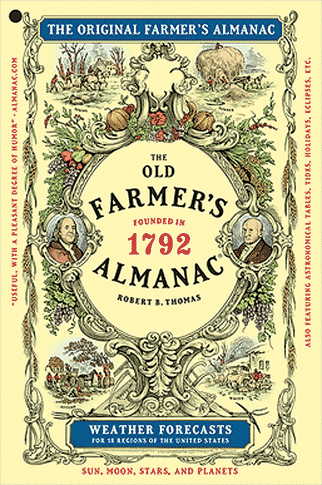
 The Old Farmer’s Almanac has been on my stocking-stuffer gift list ever since I can remember. It is interesting reading, economical, and gives both history as well as future prognostications.
The Old Farmer’s Almanac has been on my stocking-stuffer gift list ever since I can remember. It is interesting reading, economical, and gives both history as well as future prognostications.
How is that for a 2018 word of the day?
Before I take it to the Goodwill, I will share some of its 225th year anniversary issue of 2017. It is a record anniversary unmatched by any other periodical in North America. Robert B. Thomas founded it in 1792. So here we go with tips and tidbits just juicy enough to make you smile, or chuckle, or ponder, or suppose:
There was little social safety net, and no old-age pensions or Social Security in 1792. Land had value that could support the family in illness, misfortune, or old age. Those wealthy enough to trade on the New York Stock Exchange could recall that it was founded under a buttonwood tree May 17, 1792.
In 1792 the United States was an agrarian society. Ninety percent of Americans were farmers, compared with one percent today. The threshing machine allowed farmers to separate plant grain from stalks and husks, to eliminate a slow task. Tobacco growers began planting wheat.
Household pets were cats and dogs. It was for practical purposes because they helped with rodent control. A wealthy person’s pet could be a squirrel in a cage. Now I ask you, who in their right mind wants a squirrel around? They are simply a nuisance. I guess the rich in 1792 thought otherwise.
European cookbooks were available, but there were no American cookbooks published just yet. The first American cookbook “American Cookery” was written by Amelia Simmons and published in Hartford, Conn. in 1796. Prosperity in 1792 and improved transportation meant that sugar, spices, and citrus, were available to the average diet. Candle boxes and wall sconces provided light. Cooks used reflector ovens, bake pans, and biscuit-cutters. The average family burned 20 cords of wood annually.
A 1792 penny was valued 225 years ago, but not as much as it is today. Robert Birch engraved one of the first U.S. coins with “Miss Liberty” and it sold for almost $2.6 Million in 2015.
Women were the primary caregivers in 1792 (Some things never change) because doctors were scarce. Women used medicinal herbs, guidebooks, word-of-mouth and other remedies to nurse a family member back to health. Frequent bathing was considered hazardous to health. Rotten teeth were pulled by whomever was available.
The enjoyable activities in 1792 included adult church picnics, card games, horse racing, whittling, knife-throwing and jumping high enough to click the heels three times in the air. Children liked shadow pictures on a wall, finding figures in a fire’s flame and swimming, fishing, and boating. They would make dolls out of corn husks and run races or tag.
Fashion in 1792 found that men had their clothing tailor-made, but women hand-sewed theirs. The full coats worn in the 1700s were becoming more form-fitting tailcoats. Styles were simpler. The colonial tricorne hat had become the bicorne.
Wealthy families had flower and tree pleasure gardens. Most everyone kept a kitchen garden of at least one quarter acre in size and tended by the women and children and full of vegetables and herbs for food and medicine.
So, Happy 225 years, Mr. Thomas, and “Thank you for your wonderful Almanac. Be it ever and always as you set forth: Useful with a pleasant degree of humor.”

